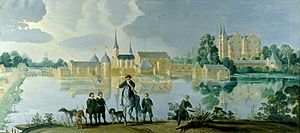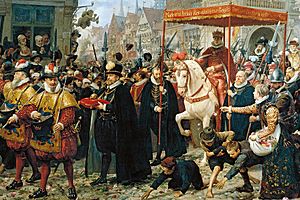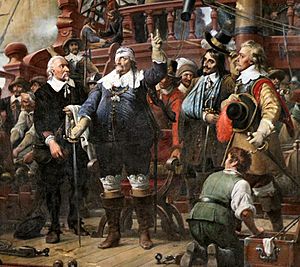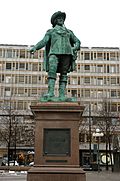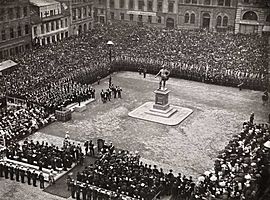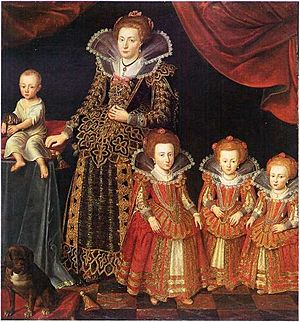Christian IV of Denmark facts for kids
Quick facts for kids Christian IV |
|
|---|---|
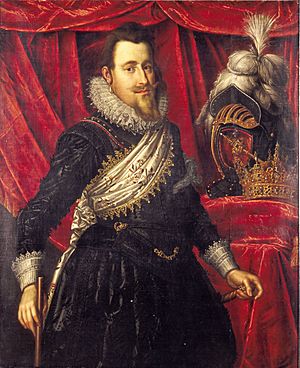
Portrait by Pieter Isaacsz, c. 1612
|
|
| King of Denmark and Norway (more...) | |
| Reign | 4 April 1588 – 28 February 1648 |
| Coronation | 29 August 1596 Copenhagen Cathedral |
| Predecessor | Frederick II |
| Successor | Frederick III |
| Born | 12 April 1577 Frederiksborg Palace |
| Died | 28 February 1648 (aged 70) Rosenborg Castle |
| Burial | Roskilde Cathedral |
| Spouse | |
| Issue among others... |
Christian, Prince-Elect of Denmark Frederick III of Denmark Ulrich Morganatic and illegitimate: Sophie Elisabeth Pentz Leonora Christina Ulfeldt Valdemar Christian of Schleswig-Holstein Elisabeth Augusta Lindenov Christiane Sehested< Hedevig Ulfeldt Dorothea Elisabeth Christiansdatter Christian Ulrik Gyldenløve Hans Ulrik Gyldenløve Ulrik Christian Gyldenløve |
| House | Oldenburg |
| Father | Frederick II of Denmark |
| Mother | Sofie of Mecklenburg-Schwerin |
| Religion | Protestantism (Lutheranism) |
| Signature |  |
Christian IV (born April 12, 1577 – died February 28, 1648) was the King of Denmark and Norway. He was also the Duke of Holstein and Schleswig. He ruled from 1588 until his death in 1648. His reign lasted for almost 60 years, making it the longest of any Danish or Scandinavian king.
Christian was part of the House of Oldenburg royal family. He started ruling Denmark on his own in 1596 when he was 19 years old. People remember him as one of Denmark's most popular and active kings. He started many new projects and made many changes. Under Christian IV, Denmark became very stable and wealthy. He led Denmark into several wars, especially the Thirty Years' War (1618–1648). This war caused a lot of damage in Germany. It also hurt Denmark's economy and made the country lose some of its lands. Christian IV also rebuilt and renamed the Norwegian capital Oslo to Christiania, a name it kept until 1925.
Contents
Early Life of Christian IV
Birth and Family History
Christian was born at Frederiksborg Castle in Denmark on April 12, 1577. He was the third child and first son of King Frederick II of Denmark–Norway. His mother was Sofie of Mecklenburg-Schwerin. Through his mother, he was a descendant of King John of Denmark. This made him the first king since Christian II to be directly related to King John.
At that time, Denmark's king was chosen by election, not automatically passed down. So, even though Christian was the oldest son, he wasn't guaranteed to be king. However, Norway's crown was passed down through family. If someone else was chosen for Denmark, it could end the union between Denmark and Norway. In 1580, when Christian was only 3 years old, his father had him elected as the next king of Denmark.
Becoming King as a Young Boy
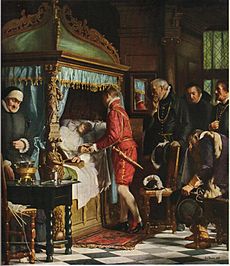
History painting by Carl Bloch, 1880.
Christian's father died on April 4, 1588. Christian was only 10 years old then. He became king, but because he was so young, a special council was formed to rule for him. This group was called the regency council. It was led by chancellor Niels Kaas. Other important members were Peder Munk, Jørgen Ottesen Rosenkrantz, and Christoffer Valkendorff. Christian's mother, Queen Dowager Sophie, wanted to help rule, but the council did not allow it. When Niels Kaas died in 1594, Jørgen Rosenkrantz took over as the head of the council.
Christian's Coronation Ceremony
Christian continued his education at Sorø Academy. He was known as a strong-willed and smart student.
In 1595, the Council of the Realm decided that Christian was almost old enough to rule on his own. On August 17, 1596, at 19 years old, Christian signed his haandfæstning. This was a document that limited the king's power, similar to the Magna Carta. It was an exact copy of the one his father signed in 1559.
Twelve days later, on August 29, 1596, Christian IV was crowned king. The ceremony took place at the Church of Our Lady in Copenhagen. He wore a new Danish Crown Regalia made just for him.
Christian's Royal Marriage
On November 30, 1597, Christian married Anne Catherine of Brandenburg. She was the daughter of Joachim Friedrich, who was the Margrave of Brandenburg and Duke of Prussia.
Christian IV's Reign
Military and Economic Changes

Christian was interested in many things, including making changes at home and improving Denmark's military. New forts were built with help from Dutch engineers. The Royal Dano-Norwegian Navy grew a lot. In 1596, it had only 22 ships, but by 1610, it had 60 ships. Some of these were even designed by Christian himself. Building a national army was harder. Christian mostly relied on hired soldiers called mercenaries, which was common back then. He also used local farmers from royal lands to join the army.
Until the early 1620s, Denmark-Norway's economy was doing very well because of good times in Europe. This made Christian want to increase Denmark-Norway's trade with other countries. This idea was part of a popular trend called mercantilism. He started many trading cities and helped build factories. He also built many buildings in the Dutch Renaissance style.
Royal Visits to England
Christian's sister, Anne, married King James VI of Scotland. James became King of England in 1603. To keep good relations between their kingdoms, Christian visited England in 1606. The visit was seen as a success. The royal group visited Upnor Castle and had dinner on a ship called the Elizabeth Jonas. Christian even put on a fireworks show for King James. After exchanging gifts, Christian sailed home.
Christian IV visited England again in August 1614. He came secretly to surprise his sister at Denmark House. He sailed with only three ships and even caught some pirates on the way! More ships with his Danish helpers arrived later. The real reason for his visit was kept secret. People heard that Anne of Denmark had written to him about a disagreement with King James.
Exploring New Lands and Colonies
Even with all Christian's efforts, his new economic projects didn't make much money. So, he looked for new ways to earn income from other places. He sent several expeditions to Greenland between 1605 and 1607. The goal was to find the lost Norse settlements and claim Greenland for Denmark. These trips were not successful. The leaders weren't used to the difficult Arctic ice and weather. An English explorer named James Hall was the pilot on all three trips.
In 1619, Christian sent an expedition to North America. It was led by Dano-Norwegian explorer Jens Munk. The ships were looking for the Northwest Passage. They landed at the mouth of the Churchill River in what is now Churchill, Manitoba. But it was a terrible journey. Most of the crew died from cold, hunger, and scurvy.
In 1618, Christian sent Admiral Ove Gjedde to start a Danish colony in Ceylon. The expedition sailed in 1618. It took two years to reach Ceylon, and more than half the crew died on the way. When they arrived in May 1620, they couldn't start a colony in Ceylon. Instead, a local ruler in India, the Nayak of Tanjore, was interested in trading. A deal was made, giving the Danes the village of Tranquebar (or Tarangamabadi) on India's south coast. They also got the right to build a "stone house" (Fort Dansborg) and collect taxes. This agreement was signed on November 20, 1620. It created Denmark's first colony in India. Christian also started the Danish East India Company.
The Kalmar War
In 1611, Christian used his new army for the first time. Even though his council didn't want to, Christian started a war with Sweden. He wanted Denmark to be the most powerful country in the Baltic Sea. This war became known as the Kalmar War. The main part of the war was Denmark capturing Kalmar, Sweden's southernmost fort. Christian forced King Gustavus Adolphus of Sweden to agree to all his main demands in the Treaty of Knäred on January 20, 1613. Even though Denmark was stronger, the war's gains were not huge.
Christian then turned his attention to the Thirty Years' War in Germany. He had two goals: first, to control the big German rivers like the Elbe and Weser. This would help him control the northern seas. Second, he wanted to get control of certain German church lands for his younger sons. He cleverly used the fears of German Protestants to get control of the See of Bremen for his son Frederick in September 1621. He made a similar deal for Verden in November. Hamburg also agreed to recognize Denmark's rule over Holstein in July 1621.
Denmark and the Thirty Years' War
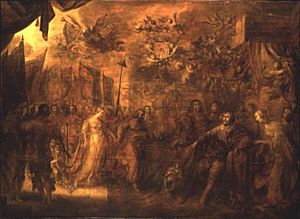
Painting by Adrian van de Venne, 1643.
Christian IV had made his kingdom very stable and wealthy, more so than almost anywhere else in Europe. Denmark earned money from tolls on the Øresund (a strait) and from war payments from Sweden. Denmark's involvement in the Thirty Years' War was helped by France and King Charles I of England. Charles agreed to help pay for the war partly because Christian was the uncle of both Charles and his sister Elizabeth of Bohemia. About 13,700 Scottish soldiers were sent to help Christian IV. Also, about 6,000 English troops arrived to help defend Denmark.
Christian entered the war on May 9, 1625, with an army of about 20,000 hired soldiers. He also had some allies from Britain and a national army of 15,000 men. He led them as the Duke of Holstein, not as the King of Denmark.
At first, Christian had some successes. But on August 27, 1626, he was defeated by Johan Tzerclaes, Count of Tilly in the Battle of Lutter. Christian had not fully planned his attack against the combined armies of the Holy Roman Emperor and the Catholic League. Promises of military help from the Netherlands and England did not happen. In the summer of 1627, both Tilly and Albrecht von Wallenstein took over the duchies and the entire Jutland peninsula.
Christian then made an alliance with Sweden on January 1, 1628. He and Gustavus Adolphus both worried about Germany expanding into the Baltic Sea area. Gustavus Adolphus promised to help Denmark with ships if needed. Soon after, a combined Swedish-Danish army and navy forced Wallenstein to stop his attack on Stralsund. With Sweden's help, Denmark's strong navy helped them get through their hardest times. In May 1629, Christian was able to make peace with the emperor in the Treaty of Lübeck. Denmark did not lose any land. However, the treaty made Christian promise not to get involved in the Thirty Years' War anymore. This removed any Danish obstacles when Gustavus Adolphus entered the war in 1630.
Controlling Sweden's Power
Christian's foreign policy didn't lose confidence after Denmark's defeat in the Thirty Years' War. To make up for lost trade money and to stop Sweden's progress in the Thirty Years' War, Christian raised the Sound Dues (tolls on ships) many times in the 1630s. Christian became more popular and powerful at home. He hoped to increase his power outside Denmark with the help of his sons-in-law, Corfitz Ulfeldt and Hannibal Sehested.
Between 1629 and 1643, Europe was full of chances for leaders who liked adventure. However, Christian couldn't keep a steady plan for his foreign policy. He wouldn't make peace with Sweden, who was his most dangerous enemy. He also didn't protect himself against Sweden by making strong alliances. Christian tried to make a deal between the Catholic side of the Thirty Years' War and Sweden. But his efforts clearly favored the Holy Roman Emperor. It was an obvious attempt to reduce Sweden's power in the Baltic Sea. His actions towards other Scandinavian countries were so annoying that Swedish leaders wanted a war with Denmark. They wanted to stop Christian from interfering in peace talks. So, in May 1643, Christian faced another war against Sweden. The higher Sound Dues had made the Dutch angry, and they started supporting Sweden.
The Torstenson War
Sweden was able to attack Denmark from both the south and the east because of their wins in the Thirty Years' War. Their alliance with the Dutch promised them control of the sea. In May 1643, the Swedish council decided to go to war. On December 12, the Swedish Field Marshal Lennart Torstensson crossed Denmark's southern border. By the end of January 1644, all of Jutland was in Swedish hands. This sudden attack, which was very skillful and fast, shocked Denmark.
Even at 66 years old, Christian showed some of the energy he had in his youth. He worked day and night to gather armies and prepare ships. Luckily for him, the Swedish government delayed fighting in Scania until February 1644. This gave the Danes time to prepare their defenses and save the important fort of Malmö. The Danish fleet stopped Torstensson from crossing from Jutland to Funen. They also defeated the Dutch ships that came to help Torstensson in a battle on May 16, 1644.
Christian IV himself stopped another attempt to move Torstensson's army to the Danish islands with a large Swedish fleet on July 1, 1644. On that day, the two fleets met at the Battle of Colberger Heide. As Christian stood on his ship, the Trinity, a Swedish cannonball hit a cannon nearby. Wood and metal pieces wounded the king in thirteen places, blinding one eye and knocking him down. But he immediately stood up again. He shouted that he was fine and stayed on deck until the fight was over, setting an example for everyone. Darkness finally separated the fleets, and the battle ended in a draw.
The Danish fleet then trapped the Swedish ships in the Bay of Kiel. But the Swedish fleet escaped. The Danish fleet was then destroyed by the combined navies of Sweden and the Netherlands. This happened after a tough fight between Fehmarn and Lolland at the end of September. This loss used up Denmark's military resources. It forced Christian to accept help from France and the Netherlands to make peace. The peace treaty, called the Treaty of Brömsebro, was signed on February 8, 1645. In this treaty, Denmark had to give up Gotland, Ösel, and (for thirty years) Halland. Norway lost the two regions of Jämtland and Härjedalen. This gave Sweden control of the Baltic Sea.
Christian IV's Impact on Norway
Christian IV spent more time in Norway than any other king from the Oldenburg family. He left a lasting mark on the Norwegian people. He visited Norway many times and founded four cities there. He also started and managed a silver mine (Kongsberg) and a copper mine (Røros). He tried to build an iron factory in Eiker, but it wasn't very successful. He also repaired and changed Akershus Castle. He invited the people of Norway to the king's official ceremony there in 1590 and again in 1610.
When the king was busy overseeing repairs and rebuilding the fort in Oslo, he lived in the countryside all summer. At the same time, he tried to set up a place to make iron in Eiker, Buskerud. History says he actually ruled the whole kingdom from this area in the summer of 1603.
In 1623, Christian visited Norway again for a whole summer. This time, he oversaw the founding of Kongsberg. He was also in the area in 1624 when Oslo burned down in August. The king was able to reach the area in a few weeks, as he was in Eiker. Over the years, fires had destroyed large parts of Oslo many times because many buildings were made entirely of wood. After the fire in 1624, which lasted for three days, Christian IV decided that the old city should not be rebuilt in the same spot. He ordered the new town to be built closer to Akershus Fortress, which later became a palace. His men built new roads, and he told all citizens to move their shops and homes to the newly built city of Christiania.
Securing Northern Lands for Denmark-Norway
During the 14th century, Swedish kings tried to expand their control northwards. Old maps sometimes showed the Norwegian coastal areas of Troms and Finnmark as part of Sweden. One of the boldest things Christian IV did was to travel to these Northern Lands. He wanted to make sure these areas stayed under the Danish-Norwegian crown.
Christian IV's Later Years and Death
After the Torstenson War, the Rigsrådet (royal council) took on a bigger role. Corfitz Ulfeldt and Hannibal Sehested led this council. The last years of Christian's life were difficult because of disagreements with his sons-in-law, especially Corfitz Ulfeldt.
On February 21, 1648, Christian asked to be carried in a special chair from Frederiksborg to his beloved Copenhagen. He died a week later. He was buried in Roskilde Cathedral. Christian IV's chapel had been finished six years before he passed away.
Christian IV: A King of Culture
Christian was seen as a typical Renaissance king. He was excellent at hiring musicians and artists from all over Europe. Many English musicians worked for him at different times, including William Brade, John Bull, and John Dowland. Dowland traveled with the king on his trips. Since he was hired in 1603, it's believed he also visited Norway. Christian was a skilled dancer, and his court was considered the second most "musical" court in Europe, only after Elizabeth I of England's court. Christian stayed in good contact with his sister Anne, who was married to King James. Christian asked Anne to get the services of Thomas Cutting, a musician who played the lute. His other sister, Elizabeth, was married to the Duke of Brunswick-Lüneburg. Artists and musicians moved freely between these royal courts.
Cities Founded by Christian IV
Christian IV is famous for founding many cities. He likely started more new cities than any other Nordic head of state in his kingdom. These towns and cities include:
- Christianopel, now Kristianopel in Sweden. Founded in 1599 in what was then Danish Blekinge. It was a military town near the border with Sweden.
- Christianstad, now Kristianstad in Sweden. Founded in 1614 in what was then Danish Skåne.
- Glückstadt, now in Germany. Founded in 1617 to compete with Hamburg in what was then Danish Holstein.
- Christianshavn, now part of Copenhagen, Denmark. Founded as a fort and military town in 1619.
- Konningsberg (King's Mountain), now Kongsberg in Norway. Founded as an industrial town in 1624 after silver was discovered.
- Christiania, now Oslo in Norway. After a big fire in 1624, the king ordered the old city of Oslo to be moved closer to Akershus Castle. He also renamed it Christiania. The city's name was changed to Kristiania in 1877 and then back to Oslo in 1924. The original part of Christiania is now called Kvadraturen (The Quarters).
- Christian(s)sand, now Kristiansand in Norway. Founded in 1641 to help trade in Southern Norway.
- Røros, now in Norway. Founded as an industrial town after copper was discovered.
One town that didn't last long was:
- Christianspris, now in Schleswig, Germany. Founded as a military town near Kiel in what was then Danish Holstein.
Christian is also known for building many important structures in his kingdom. These include the Rundetårn observatory, the Børsen (stock exchange), the Kastellet fortress in Copenhagen, Rosenborg Castle, the Nyboder workers' district, the Holmen Church (Holmens Kirke) for the navy in Copenhagen, Proviantgården, a brewery, the Tøjhus Museum (arsenal), and two Trinity Churches in Copenhagen and modern Kristianstad. Christian changed Frederiksborg Castle into a Renaissance palace. He also completely rebuilt Kronborg Castle into a strong fortress. He also started the Danish East India Company, inspired by the similar Dutch company.
Christian IV's Legacy
When Christian became king, Denmark-Norway was the most powerful country in the Baltic Sea. He later lost this power to Sweden. However, Christian is still one of the few kings from the House of Oldenburg family who is remembered fondly by both Danish and Norwegian people. He is even featured in the Danish national play Elverhøj. His many building projects also helped him become popular.
Christian IV spoke Danish, German, Latin, French, and Italian. He was naturally cheerful and welcoming. He loved lively company. He was also brave, had a strong sense of duty, loved to work tirelessly, and had the curious and creative energy of someone who loved to make improvements. The Christian IV Glacier in Greenland is named after him.
Christian IV in Stories and Films
- Christian IV appears as a smart but hard-drinking king in the alternate-history novels 1634: The Baltic War and 1637: No Peace Beyond the Line by Eric Flint and David Weber.
- Christian IV is featured several times in The Legend of the Ice People book series.
- Christian IV is also a main character in the novel Music and Silence by Rose Tremain. This book is mostly set at the Danish court in 1629 and 1630.
- The Danish alternative music band Mew describes Christian IV as a difficult person but a good king who helped his kingdom grow in their song, "King Christian".
- Christian IV - Den sidste rejse (2018) is a biographical movie. It focuses on King Christian IV's difficult relationship with Kirsten Munk. It also shows his final hours on his journey from Frederiksborg Castle to Rosenborg Castle on his deathbed.
Christian IV's Family Life
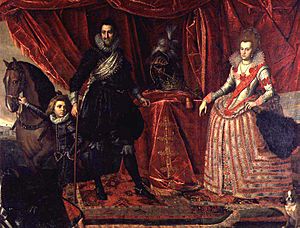
His first queen was Anne Catherine. They were married from 1597 to 1612. She passed away after having seven children with Christian. In 1615, three years after her death, the king privately married Kirsten Munk. They had twelve children together.
In 1628, Christian found out that his wife, Kirsten Munk, was having a relationship with one of his German officers. Christian put Munk under house arrest. She tried to hide her actions by arranging for one of her former maids, Vibeke Kruse, to become the king's mistress. In January 1630, their marriage officially ended, and Kirsten moved to her estates in Jutland. Meanwhile, Christian openly acknowledged Vibeke as his mistress, and she had several more children with him.
With his first wife, Anne Catherine of Brandenburg, he had the following children:
- Stillborn son (1598).
- Frederik (August 15, 1599 – September 9, 1599).
- Christian (April 10, 1603 – June 2, 1647).
- Sophie (January 4, 1605 – September 7, 1605).
- Elisabeth (March 16, 1606 – October 24, 1608).
- Frederick III (March 18, 1609 – February 9, 1670).
- Ulrik (February 2, 1611 – August 12, 1633); he was murdered.
With his second wife, Kirsten Munk, he had 12 children:
- Stillborn child (born and died 1615).
- Unnamed infant (born and died 1617).
- Countess Anna Cathrine of Schleswig-Holstein (August 10, 1618 – August 20, 1633).
- Countess Sophie Elisabeth of Schleswig-Holstein (September 20, 1619 – April 29, 1657).
- Countess Leonora Christina of Schleswig-Holstein (July 8, 1621 – March 16, 1698).
- Count Valdemar Christian of Schleswig-Holstein (June 26, 1622 – February 26, 1656).
- Countess Elisabeth Auguste of Schleswig-Holstein (December 28, 1623 – August 9, 1677).
- Count Friedrich Christian of Schleswig-Holstein (April 26, 1625 – July 17, 1627).
- Countess Christiane of Schleswig-Holstein (July 15, 1626 – May 6, 1670).
- Countess Hedwig of Schleswig-Holstein (July 15, 1626 – October 5, 1678).
- Countess Maria Katharina of Schleswig-Holstein (May 29, 1628 – September 1, 1628).
- Countess Dorothea Elisabeth of Schleswig-Holstein (September 1, 1629 – March 18, 1687).
With Kirsten Madsdatter:
- Christian Ulrik Gyldenløve (1611–1640).
With Karen Andersdatter:
- Dorothea Elisabeth Gyldenløve (1613–1615).
- Hans Ulrik Gyldenløve (1615–1645).
With Vibeke Kruse:
- Ulrik Christian Gyldenløve (1630–1658).
- Elisabeth Sophia Gyldenløve (1633–1654).
Images for kids
-
Sculpture by Christian IV in Roskilde Cathedral by Bertel Thorvaldsen
-
Statue of Christian IV at the city hall in Kristianstad by Bertel Thorvaldsen
-
Sculpture of Christian IV meeting the king of Sweden, Gustav II Adolf in Halmstad
Titles and Style
In the 1621 Treaty of The Hague and Treaty of Bremen, Christian was called "Lord Christian the Fourth, King of all Denmark and Norway, the Goths and the Wends, duke of Schleswig, Holstein, Stormarn, and Ditmarsh, count of Oldenburg and Delmenhorst, etc."
See also
 In Spanish: Cristián IV de Dinamarca para niños
In Spanish: Cristián IV de Dinamarca para niños


